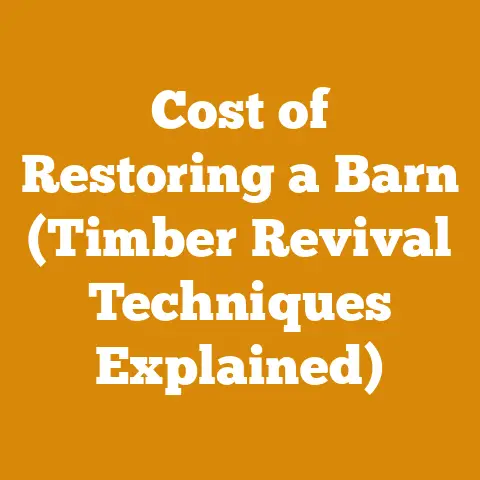Chainsaw Brush Blade Tips (5 Pro Secrets for Tough Wood)
I’ve seen some incredible advancements in chainsaw technology lately. Brush blades, in particular, have come a long way. I remember back in the day, we were stuck with flimsy, unreliable blades that would dull after just a few uses. Now, we have access to high-quality brush blades that can tear through tough wood like butter.
Chainsaw Brush Blade Tips (5 Pro Secrets for Tough Wood)
Using a chainsaw with a brush blade can be a game-changer for clearing dense vegetation and tackling challenging wood. Over the years, I’ve learned a few tricks that can significantly improve your efficiency and safety. Here are my top five pro secrets for using chainsaw brush blades when dealing with tough wood.
1. Choosing the Right Blade
Selecting the correct brush blade is crucial for optimal performance and safety. Not all blades are created equal, and using the wrong one can lead to frustration, damage, or even injury.
Types of Brush Blades
There are several types of brush blades available, each designed for specific tasks:
- Circular Saw Blades: These are typically made of steel and have teeth designed for cutting through wood and brush. They are ideal for clearing small trees and thick brush.
- Brush Cutter Blades: These blades often have multiple cutting edges or flails and are designed for clearing dense undergrowth and weeds. They are less effective on thicker wood but excel at clearing large areas quickly.
- Chainsaw Tooth Blades: These blades feature chainsaw-like teeth and are designed for cutting through thicker wood and small trees. They offer a good balance between cutting power and versatility.
Material and Construction
The material and construction of the blade play a significant role in its durability and performance.
- Steel Blades: These are the most common type of brush blade and offer a good balance of strength and affordability. Look for high-carbon steel blades for increased durability.
- Carbide-Tipped Blades: These blades have carbide tips brazed onto the cutting edges, providing exceptional wear resistance and cutting performance. They are more expensive but can last significantly longer, especially when cutting through abrasive materials.
- Forged Blades: Forged blades are made from a single piece of steel, offering superior strength and durability compared to stamped blades. They are less prone to bending or breaking under stress.
Blade Size and Tooth Count
The size and tooth count of the blade should be appropriate for the size of your chainsaw and the type of wood you are cutting.
- Blade Diameter: Larger blades can cut through thicker wood but require more power from the chainsaw. Ensure that the blade diameter is compatible with your chainsaw’s specifications.
- Tooth Count: Blades with more teeth generally provide a smoother cut but can be slower to cut through thicker wood. Blades with fewer teeth are more aggressive but may produce a rougher cut.
My Experience: I once used a low-quality steel blade to clear a patch of thorny bushes and small trees. The blade dulled quickly, and I ended up spending more time sharpening it than cutting. After switching to a carbide-tipped blade, the difference was night and day. The carbide blade sliced through the brush with ease and held its edge for much longer.
Actionable Tip: Before purchasing a brush blade, consider the type of wood you will be cutting and the power of your chainsaw. Opt for a high-quality blade made from durable materials like carbide-tipped steel for optimal performance and longevity.
Takeaway: Choosing the right brush blade is essential for efficient and safe wood processing. Consider the type of wood, blade material, size, and tooth count to ensure you have the right tool for the job.
2. Mastering Cutting Techniques
Proper cutting techniques are essential for maximizing the effectiveness of your brush blade and minimizing the risk of kickback or other accidents. I’ve learned that patience and precision are key.
Basic Cutting Techniques
- Plunge Cutting: This technique involves inserting the tip of the blade directly into the wood. It is useful for cutting through thick branches or small trees. Be cautious of kickback when using this technique.
- Sweeping Cut: This technique involves sweeping the blade from side to side to clear brush and small vegetation. It is effective for clearing large areas quickly.
- Notching: This technique involves cutting a notch into the wood before making a full cut. It helps to control the direction of the fall and prevent the wood from pinching the blade.
Advanced Cutting Techniques
- Hinge Cutting: This technique involves leaving a small amount of uncut wood (the hinge) to control the direction of the fall. It is useful for felling trees in a specific direction.
- Boring Cut: This technique involves drilling a hole into the wood with the tip of the blade. It is useful for relieving tension in the wood and preventing it from splitting.
- Step Cutting: This technique involves making a series of small cuts to gradually work your way through thicker wood. It is useful for reducing the risk of kickback and maintaining control.
Avoiding Kickback
Kickback is a common and dangerous hazard when using a chainsaw with a brush blade. It occurs when the tip of the blade catches on the wood, causing the chainsaw to suddenly kick back towards the operator.
- Use the Correct Blade: Ensure that you are using the correct blade for the type of wood you are cutting. Using the wrong blade can increase the risk of kickback.
- Maintain Proper Posture: Keep your body balanced and maintain a firm grip on the chainsaw. Avoid overreaching or cutting above shoulder height.
- Avoid Pinching: Be aware of the potential for the wood to pinch the blade, especially when cutting through thick branches or trees. Use wedges to keep the cut open and prevent pinching.
- Cut at the Correct Angle: Avoid cutting at extreme angles, as this can increase the risk of kickback. Keep the blade parallel to the wood as much as possible.
My Experience: I once experienced a severe kickback while attempting a plunge cut on a fallen log. The blade caught on a knot in the wood, causing the chainsaw to kick back violently. Fortunately, I was wearing proper safety gear and was able to maintain control of the chainsaw, but it was a close call. This experience taught me the importance of being aware of the potential for kickback and using proper cutting techniques.
Actionable Tip: Practice your cutting techniques in a safe and controlled environment before tackling more challenging projects. Always be aware of the potential for kickback and take steps to minimize the risk.
Takeaway: Mastering cutting techniques is crucial for safe and efficient wood processing. Practice basic and advanced techniques, and always be aware of the potential for kickback.
3. Chainsaw Maintenance and Sharpening
Regular maintenance and sharpening are essential for keeping your chainsaw and brush blade in optimal condition. A dull blade is not only less efficient but also more dangerous.
Chainsaw Maintenance
- Air Filter: Clean the air filter regularly to ensure proper airflow to the engine. A dirty air filter can reduce engine performance and increase fuel consumption.
- Spark Plug: Inspect the spark plug regularly and replace it if it is fouled or damaged. A worn spark plug can cause starting problems and reduce engine performance.
- Fuel Filter: Replace the fuel filter regularly to prevent debris from entering the carburetor. A clogged fuel filter can cause engine stalling and poor performance.
- Chain Tension: Check the chain tension regularly and adjust it as needed. A loose chain can increase the risk of kickback and damage the chainsaw.
- Lubrication: Ensure that the chain is properly lubricated with chain oil. Proper lubrication reduces friction and extends the life of the chain and bar.
Brush Blade Sharpening
- Visual Inspection: Before sharpening your brush blade, inspect it for any signs of damage, such as cracks or bent teeth. Replace the blade if it is damaged.
- Sharpening Tools: Use a file or grinding wheel specifically designed for sharpening chainsaw blades. Ensure that the file or grinding wheel is the correct size and shape for your blade.
- Sharpening Angle: Maintain the correct sharpening angle when sharpening the teeth of the blade. The correct angle will vary depending on the type of blade.
- Consistent Sharpening: Sharpen each tooth evenly to ensure that the blade cuts smoothly and efficiently. Avoid over-sharpening the teeth, as this can weaken them.
- Deburring: After sharpening the blade, remove any burrs or sharp edges with a file or grinding wheel. Burrs can cause the blade to catch on the wood and increase the risk of kickback.
My Experience: I used to neglect chainsaw maintenance and sharpening, thinking it was a waste of time. However, I quickly learned that a well-maintained and sharpened chainsaw is much more efficient and safer to use. I once spent an entire day struggling to cut through a pile of logs with a dull chain. After taking the time to sharpen the chain, I was able to cut through the remaining logs in a fraction of the time.
Actionable Tip: Develop a regular maintenance schedule for your chainsaw and brush blade. Sharpen the blade after each use or when you notice a decrease in cutting performance.
Takeaway: Regular chainsaw maintenance and brush blade sharpening are essential for optimal performance and safety. Keep your chainsaw clean, lubricated, and properly tuned, and sharpen your brush blade regularly.
4. Safety Gear and Precautions
Safety should always be your top priority when using a chainsaw with a brush blade. Wearing the appropriate safety gear and following safety precautions can significantly reduce the risk of injury.
Required Safety Gear
- Helmet: Wear a helmet with a face shield or safety glasses to protect your head and face from flying debris.
- Hearing Protection: Wear earplugs or earmuffs to protect your hearing from the loud noise of the chainsaw.
- Gloves: Wear heavy-duty gloves to protect your hands from cuts, scrapes, and vibrations.
- Chaps: Wear chainsaw chaps to protect your legs from accidental cuts.
- Steel-Toed Boots: Wear steel-toed boots to protect your feet from falling objects and accidental cuts.
Safety Precautions
- Read the Manual: Read and understand the chainsaw’s owner’s manual before using it.
- Inspect the Area: Inspect the area for hazards, such as rocks, roots, and overhead obstructions.
- Clear the Area: Clear the area of any bystanders or obstacles that could interfere with your work.
- Start the Chainsaw Safely: Start the chainsaw on a flat, stable surface and keep your feet away from the blade.
- Maintain a Safe Distance: Maintain a safe distance from other workers and avoid cutting in close proximity to power lines or other hazards.
- Take Breaks: Take frequent breaks to avoid fatigue, which can increase the risk of accidents.
- Never Cut Above Shoulder Height: Avoid cutting above shoulder height, as this can make it difficult to control the chainsaw.
- Be Aware of Your Surroundings: Be aware of your surroundings and watch out for wildlife or other potential hazards.
My Experience: I once witnessed a serious accident involving a chainsaw. A worker was cutting down a tree without wearing proper safety gear. The tree fell unexpectedly and struck the worker, causing serious injuries. This incident reinforced the importance of wearing safety gear and following safety precautions at all times.
Actionable Tip: Always wear the appropriate safety gear when using a chainsaw with a brush blade. Take the time to inspect the area and clear any hazards before starting work.
Takeaway: Safety should always be your top priority when using a chainsaw with a brush blade. Wear the appropriate safety gear and follow safety precautions to minimize the risk of injury.
5. Wood Type Considerations
Different types of wood have varying densities and characteristics, which can affect the performance of your brush blade. Understanding these differences can help you choose the right blade and cutting techniques for the job.
Hardwoods vs. Softwoods
- Hardwoods: Hardwoods, such as oak, maple, and hickory, are denser and more difficult to cut than softwoods. They require a more aggressive blade and more power from the chainsaw.
- Softwoods: Softwoods, such as pine, fir, and cedar, are less dense and easier to cut than hardwoods. They can be cut with a less aggressive blade and require less power from the chainsaw.
Wood Density
- Density Measurement: Wood density is typically measured in pounds per cubic foot (lb/ft³). The higher the density, the harder the wood.
- Density Impact: High-density woods can dull blades more quickly and require more frequent sharpening. They also tend to produce more sawdust.
Moisture Content
- Green Wood: Green wood, or freshly cut wood, has a high moisture content, which can make it more difficult to cut. The moisture can cause the blade to bind and increase the risk of kickback.
- Dry Wood: Dry wood has a lower moisture content and is generally easier to cut. However, extremely dry wood can be brittle and prone to splitting.
- Optimal Moisture: The optimal moisture content for cutting wood is typically between 20% and 30%. This level of moisture provides a good balance between ease of cutting and stability.
Grain Patterns
- Straight Grain: Wood with a straight grain is easier to cut than wood with a twisted or interlocked grain. The blade can follow the grain more easily, resulting in a smoother cut.
- Twisted Grain: Wood with a twisted or interlocked grain can be more difficult to cut, as the blade may tend to wander or bind. It requires more skill and precision to cut this type of wood.
My Experience: I once attempted to cut through a large oak log with a dull brush blade. The blade struggled to penetrate the wood, and I ended up spending hours trying to make a single cut. After switching to a sharper blade and using a more aggressive cutting technique, I was able to cut through the log much more easily. This experience taught me the importance of understanding the properties of different types of wood and using the appropriate tools and techniques.
Actionable Tip: Identify the type of wood you will be cutting before starting work. Choose the right blade and cutting techniques based on the wood’s density, moisture content, and grain pattern.
Takeaway: Understanding the properties of different types of wood is essential for efficient and safe wood processing. Consider the wood’s density, moisture content, and grain pattern when choosing the right blade and cutting techniques.
By following these five pro secrets, you can significantly improve your efficiency and safety when using a chainsaw with a brush blade to tackle tough wood. Remember to choose the right blade, master cutting techniques, maintain your chainsaw, wear safety gear, and consider wood type. Happy cutting!






